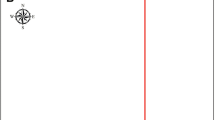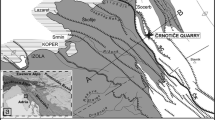Abstract
The Ground Penetrating Radar (GPR) is a newly developing geophysical tool for imaging the sub-surface and is potentially useful in groundwater exploration. We test its usefulness in characterizing a groundwater rich lineament near Gajularamaram in the Hyderabad granite terrain, where groundwater is limited to soil, weathering zone and lineaments. The lineament is 2 km long and 50–100 m wide, and oriented in WNW-ESE direction. It is characterized by many closely spaced sub-vertical fractures and faults, majority of which are parallel to the lineament. On either sides of the lineament, sub-horizontal sheet joints are abundant. The lineament is saturated with groundwater that discharge as springs at some places. About 450 m long, 400–100 MHz GPR data (∼5–30 m depth) were acquired along five profiles across the lineament. In the lineament, soil thickness varies from ∼0.5 m to 5 m, and is underlain by weathered granite. In the WNW part, a thick weathering zone (∼15 m) is present and a 10 m wide vertical anomaly zone (lineament) is also present. The presence of shallow reflectors at 1 m depth in the lineament is attributed to the groundwater surface. The GPR images reveal many sub horizontal to gently dipping reflectors, which are interpreted to be the sheet joints. The GPR data clearly reveal the saturated lineament, from which groundwater may migrate laterally to long distance through the sheet joints. We demonstrate the GPR as a rapid geophysical tool that can be used successfully to explore the nearsurface groundwater.
Similar content being viewed by others
References
Asadi, S. S., Vuppala, P., and Reddy, M. A. (2007) Remote sensing and GIS techniques for evaluation of groundwater quality in Municipal Corporation of Hyderabad (Zone-V), India, Int. Jour. Environ. Res. Public Health, v.4, pp.45–52.
Carreon-freyre, D.C. and Cerca, M., (2006) Delineating the nearsurface geometry of the fracture system affecting the Querétaro valley, Mexico: Correlation of GPR signatures and physical properties of sediments. Near Surface Geophysics, pp.49–55
Chadwick, B., Vasudev, V. N. and Hegde, G. V. (2000) The Dharwar craton, southern India, interpreted as the result of late Archaean oblique convergence. Precambrian Res., v.99, pp.91–111.
Goldman, M. and Neubauer, F. M. (1994) Groundwater exploration using integrated geophysical techniques. Surveys in Geophysics, v.15, pp.331–361.
Haeni, F.P. (1986) Application of seismic refraction methods in groundwater modeling studies in New England, Geophysics, v.51, pp.236–249.
Liu, L. and Li, Y., (2001) Identification of liquefaction and deformation features using ground penetrating radar in the New Madrid seismic zone, USA, Jour. Appld. Geophysics, v.47, pp.199–215.
Jol, H.M. (2009) (ed.), Ground Penetrating Radar Theory and Applications, Elsevier, Amsterdam, 524p.
Menon, R., Senthil Kumar, P., Reddy, G.K. and Seshunarayana, T. (2010) Anomalous soil-gas helium escape in 1982 Gundipet micro-earthquake zone, Hyderabad. Curr. Sci., v.98, pp.1187–1189.
Mysaiah, D., Maheswari, K., Sri Hari Rao, M., Senthil Kumar, P. and Seshunarayana, T. (2010) Ground penetrating radar applied to imaging sheet joints in granite bedrock, Curr. Sci., v.100, pp.473–475.
Reddy, G. K., Menon, R., Seshunarayana, T. and Senthil Kumar, P. (2010) Soil-gas helium and surface waves detect fracture and fault zones in shallow granite basement. Jour. Earth Syst. Sci., v.119, pp.745–751.
Senthil Kumar, P.S. and Reddy, G.K. (2004) Radioelements and heat production of an exposed Archaean crustal cross-section, Dharwar craton, south India, Earth Planet. Sci. Lett., v.224, pp.309–324.
Seshunarayana, T., Satish Kumar, K., Deenanadh, S., Rama Mohan Rao, Y. and Senthil Kumar, P. (2008b) Subsurface imaging of dolerite dykes in Hyderabad granite terrain using multi-channel analysis of surface waves. In: R. K. Srivastava, Ch. Sivaji and N.V. Chalapathi Rao (Eds.), Indian Dykes. Narosa Publishing House, New Delhi, pp.331–338.
Seshunarayana, T., Senthil Kumar, P., Sampath Rao, V., Mysaiah, D., Satish Kumar, K. and Pavan Kishore, P. (2008a) Multichannel analysis of surface waves reveals shear zones and fractures in a shallow granite basement: Wailapally watershed near Hyderabad. Jour. Geol. Soc. India, v.71, pp.261–265.
Author information
Authors and Affiliations
Corresponding author
Rights and permissions
About this article
Cite this article
Maheswari, K., Senthil Kumar, P., Mysaiah, D. et al. Ground penetrating radar for groundwater exploration in granitic terrains: A case study from Hyderabad. J Geol Soc India 81, 781–790 (2013). https://doi.org/10.1007/s12594-013-0103-x
Received:
Revised:
Published:
Issue Date:
DOI: https://doi.org/10.1007/s12594-013-0103-x




